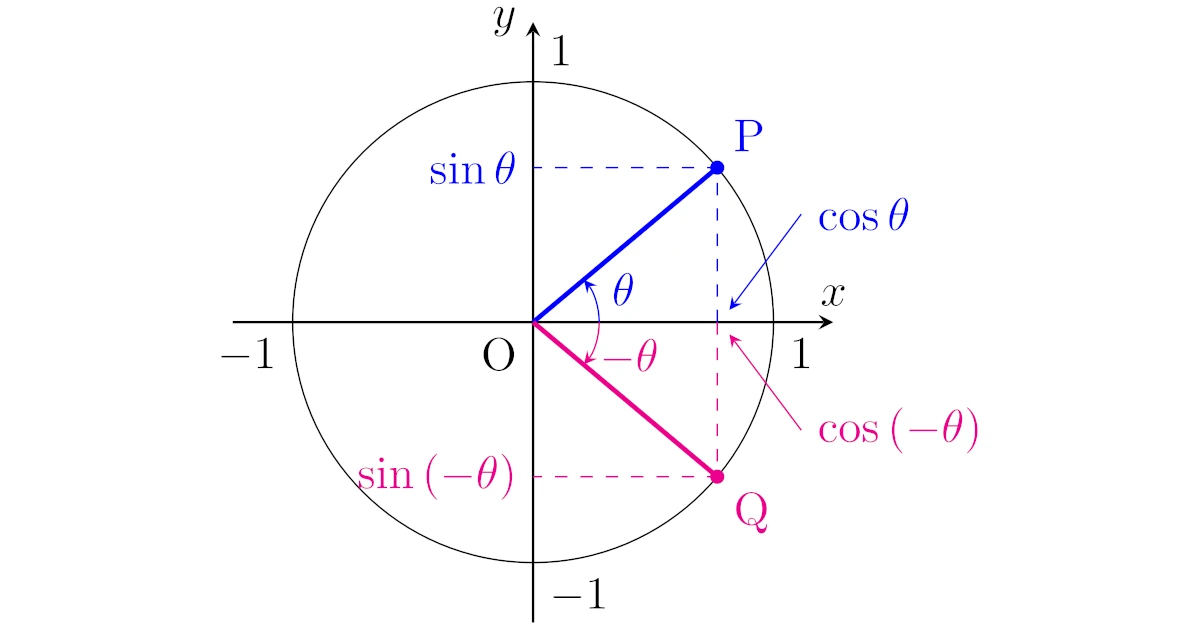数学IAでは三角比$\sin{\theta}$, $\cos{\theta}$, $\tan{\theta}$について,(90°-θ)型の公式と(180°-θ)型の公式が成り立つことを学びました.
数学IIBで学ぶ三角関数$\sin{\theta}$, $\cos{\theta}$, $\tan{\theta}$では$\theta$が実数全体を動くので,$\tan{(180^\circ+\theta)}$や$\sin{(90^\circ+\theta)}$などの変換も扱えるようになる必要があります.
教科書ではそのような公式がたくさん並んでいて「これらを覚えないといけないのか……」と考えてしまう方は多いのですが,実はそのうちのほとんどの公式は覚える必要はありません!
分かりやすい公式を少し覚えておくだけで,他の偏角の変換公式は全て導けるようになっています.
今回の記事では
- 3タイプの基本の変換公式
- 他の変換公式の導き方
を順に説明します.
「三角関数」の一連の記事
3タイプの基本の変換公式
以下の三角関数の公式は図を考えればすぐに分かります.まずはこれらを理解しましょう.
実数$\theta$に対して,次が成り立つ.
- $\begin{cases}\cos{(\theta\pm180^{\circ})}=-\cos{\theta}\\\sin{(\theta\pm180^{\circ})}=-\sin{\theta}\end{cases}$
- $\begin{cases}\cos{(-\theta)}=\cos{\theta}\\\sin{(-\theta)}=-\sin{\theta}\end{cases}$
- $\begin{cases}\cos{(90^{\circ}-\theta)}=\sin{\theta}\\\sin{(90^{\circ}-\theta)}=\cos{\theta}\end{cases}$
これらの公式は全部で
- タイプ1:$(\theta\pm180^{\circ})$型の公式
- タイプ2:$(-\theta)$型の公式
- タイプ3:$(90^{\circ}-\theta)$型の公式
の3タイプですね.以下では,点Oを原点,点Pを単位円周上の偏角$\theta$の点$(\cos{\theta},\sin{\theta})$とします.
タイプ1:$(\theta\pm180^\circ)$型の公式
単位円周上の点Pと原点対称な点をQとすると,点Qの偏角は$\theta+180^\circ$, $\theta-180^\circ$のどちらとも言えるので,点Qの座標は
ですね.
点Pと点Qについて$x$座標も$y$座標もともに正負が逆になっているので,$(\theta\pm180^{\circ})$型の公式
が得られますね.
タイプ2:$(-\theta)$型の公式
単位円周上の点Pと$x$軸対称な点をQとすると,点Qの偏角は$-\theta$なので,点Qの座標は
ですね.
点Pと点Qについて$x$座標は等しく,$y$座標は正負が逆になっているので,$(-\theta)$型の公式
が得られますね.
タイプ3:$(90^\circ-\theta)$型の公式
$0<\theta<90^\circ$の三角比の場合に(90°-θ)型の公式の変換公式が成り立つことは数学IAで学びました.ここでも確認しておきましょう.
$\ang{A}=\theta$, $\ang{B}=90^{\circ}$の直角三角形$\tri{ABC}$を考えると,$\ang{C}=90^{\circ}-\theta$ですね.
よって,三角比の定義から
が得られますね.
この証明は$0<\theta<90^\circ$の場合のみの証明となっていますが,任意の実数$\theta$に対して成り立つことも証明できます(この証明はこの記事の最後を参照).
他の変換公式の導き方
他のタイプの偏角の変換公式は,上でみた3タイプの基本の変換公式から導けます.
(再掲)実数$\theta$に対して,次が成り立つ.
- $\begin{cases}\cos{(\theta\pm180^{\circ})}=-\cos{\theta}\\\sin{(\theta\pm180^{\circ})}=-\sin{\theta}\end{cases}$
- $\begin{cases}\cos{(-\theta)}=\cos{\theta}\\\sin{(-\theta)}=-\sin{\theta}\end{cases}$
- $\begin{cases}\cos{(90^{\circ}-\theta)}=\sin{\theta}\\\sin{(90^{\circ}-\theta)}=\cos{\theta}\end{cases}$
以下でいくつか具体的に求めてみましょう.以下のものくらいなら慣れれば数秒で導けるようになります.
変換公式の例1($\cos(-180^{\circ}-\theta)$)
$\cos(-180^{\circ}-\theta)$を簡単にせよ.
$(\theta-180^\circ)$型の変換公式と$(-\theta)$型の変換公式を使います.
変換公式の例2($\sin(\theta-90^{\circ})$)
$\sin(\theta-90^{\circ})$を簡単にせよ.
$90^\circ$が絡む場合は$(90^\circ-\theta)$型の公式に持ち込むのが鉄板です.
変換公式の例3($\sin(90^{\circ}+\theta)$)
$\sin(90^{\circ}+\theta)$を簡単にせよ.
今回も$90^\circ$が絡むので,やはり$(90^\circ-\theta)$型の公式を使います.
変換公式の例4($\tan(180^{\circ}-\theta)$)
$\tan(180^{\circ}-\theta)$を簡単にせよ.
$\tan$の変換公式は$\tan$の定義$\tan{\theta}=\dfrac{\sin{\theta}}{\cos{\theta}}$を用いて$\sin$, $\cos$を使って表してから,それぞれで変換公式を使えば良いですね.
一般の場合の$(90^\circ-\theta)$型の公式の証明
先ほどの$(90^\circ-\theta)$型の公式
は$0<\theta<90^\circ$の三角比の場合のものでしたから,任意の$\theta$に対しても成り立つことを示しておきましょう.
(再々掲)実数$\theta$に対して,次の$(90^{\circ}-\theta)$型の公式が成り立つ.
さまざまな証明方法がありますが,ここでは$(-\theta)$型の変換公式と合わせることで示しましょう.
単位円周上の偏角$-\theta$の点Pを原点中心に$90^\circ$回転させた点をQとすると,点Qの座標は
である.
この図で線分OP,線分OQを斜辺とする2つの直角三角形の合同を考えて,
が成り立つ.$(-\theta)$型の変換公式と併せて
と$(90^\circ-\theta)$型の変換公式が得られる.
このように一般の実数$\theta$の場合の証明は少し手間ですが,直角三角形の場合を考えれば公式自体を覚えるのは簡単ですね.

コメント